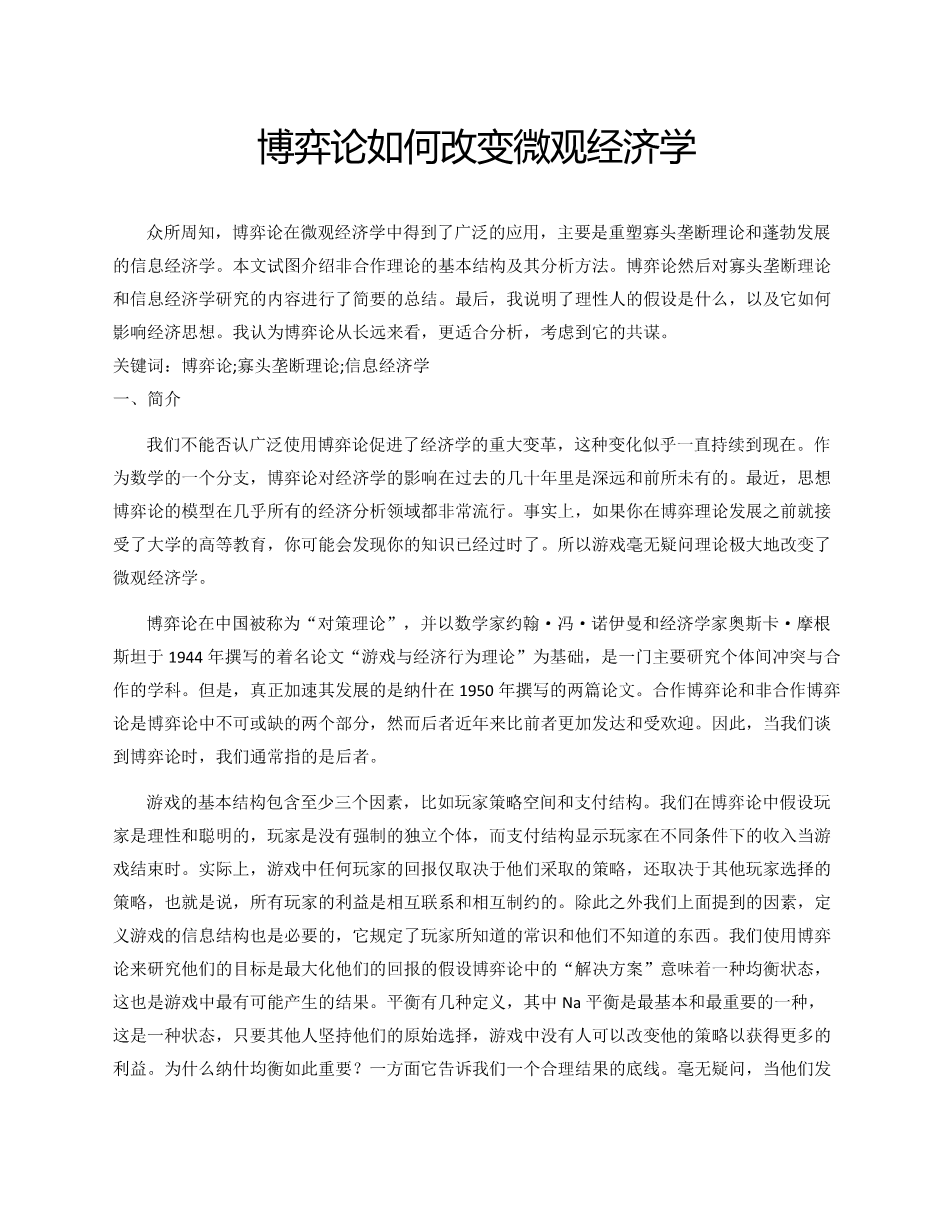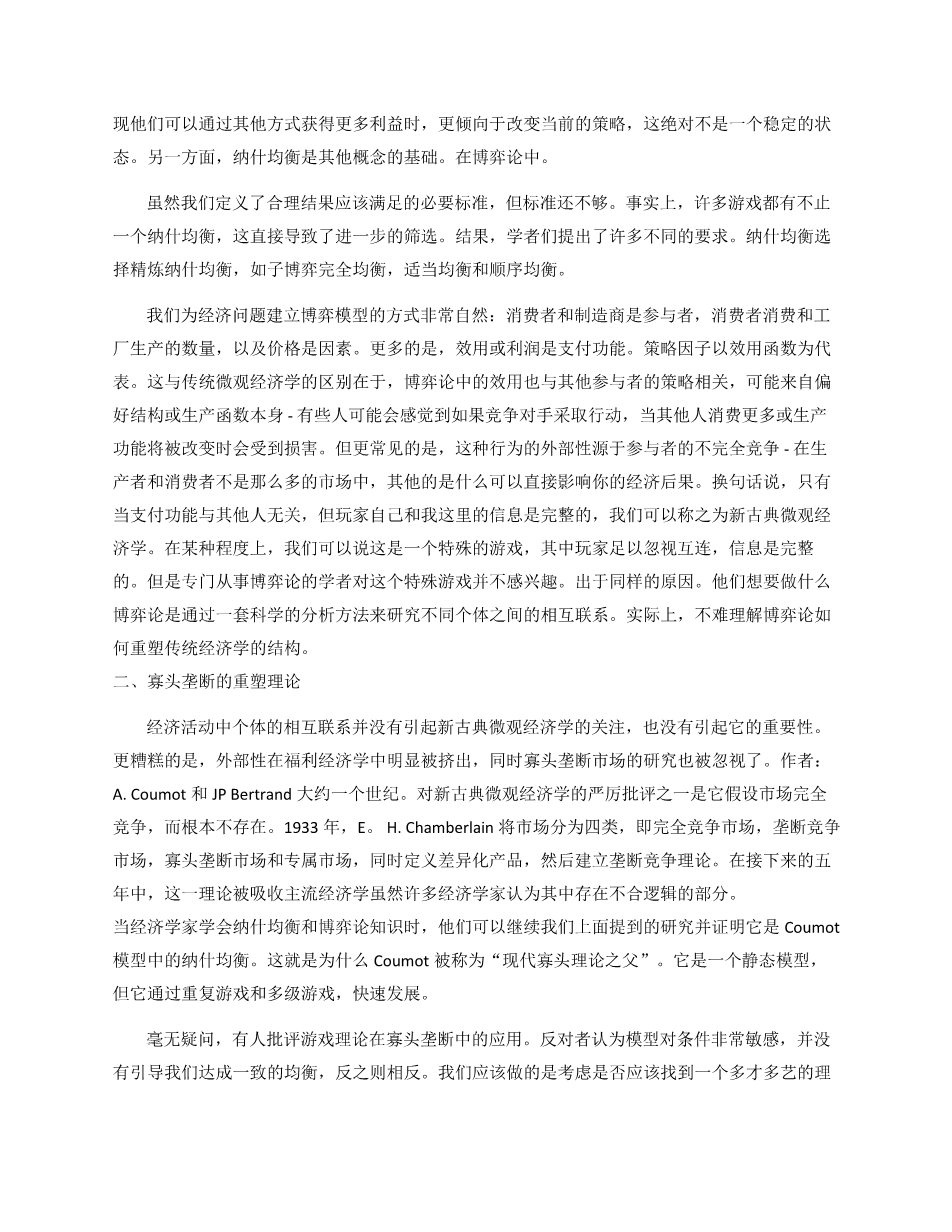How game theory change microeconomics
Abstract:As we all know ,game theory has been widely used in microeconomics which is mainly in reshaping Theory of Oligopoly and booming information economics.In this paper ,I try to introduce the elemental structure ,together with methods of analyzing, of non-cooperative game theory and then make a brief summary about the content of studies of Theory of Oligopoly and information economics.At last ,I state the what the hypothesis,namely,rational man ,is ,and how it affects economic thoughts.I believe that game theory is more suitable of analysis in a long run,taking into account its complicity.
Keywords: game theory;Theory of Oligopoly;information economics
1.Introduction
We can not deny that the extensive use game theory has boosted a significant change in economics which appears to continue until now.As a branch of mathematics,what influence game theory had on economics is profound and unprecedented in last few decades.Recently,the thoughts and models of game theory has been very popular in almost every field of economic analysis.In fact,if you received high education in university before game theory has its day,you may find your knowledge out of date.So there is no doubt that game theory has changed microeconomics greatly.
Game theory which is also called “theory of countermeasures” in Chinese and based on the famous paper named Theory of Games and Economic Behavior written by mathematician John von Neumann and economist Oskar Morgenstern in 1944 is a discipline that mainly study the conflicts and cooperation among individuals.Yet,what really speed up its development is two dissertations written by Nash in 1950s.Cooperative game theory and non-cooperative game theory are two indispensable parts of game theory,however the latter is far more developed and popular than the former in recent years.Therefore when we speak of game theory ,we usually mean the latter.
Fundamental structure of a game contains at least three factors ,say,player strategy space and payoff structure.We in game theory assume that players are rational and smart,players are independent individuals under no coercion,and payoff structure shows players’ earnings in different conditions when the game ends.Actually,the payoff of any player in the game is merely depending on the strategies they take but also the strategies that other players choose,that is to say,benefits of all players are interconnected and mutually restricted.Besides the three factors we mention above,defining a information structure of the game is also necessary,which specifies what the players know as common sense and what they do not.We use game theory to study their actions under the hypothesis that their goals are to maximize their payoff.A ‘solution’ in game theory means a state of equilibrium which is also the most likely result in a game.There are several definitions of equilibrium,among which Nash equilibrium is the most fundamental and important one,which is a state that no one in the game can change his strategy to get more benefits as long as others hold on to their original choices.And why Nash equilibrium is so important?On one hand,it tells us a bottom line of reasonable results.One undoubtedly prefer to change current strategy when they find they can benefit more in other ways,which is absolutely not a stable state.On the other hand,Nash equilibrium is the basis of other conceptions in game theory.
Though we define the necessary standard that a reasonable result should meet,the standard is not sufficient.As a matter of fact,many games have more than one Nash equilibrium,which directly lead to further screening.As a result,scholars add many different requirements to Nash equilibrium to select refining Nash equilibrium,such as subgame perfect equilibrium,proper equilibrium and sequential equilibrium.
The way we establish game models for economic matters is very natural: consumers and manufacturers are players ,the quantity consumed by consumers and manufactured by factories,together with price are factors.What ‘s more,utility or profit is payoff function.The connection of strategy factor is represented by utility function.The difference between this and traditional micro-economic is that utility in game theory is relevant to other players’ strategies too,which may come from the preference structure or the production function itself--some people may feel damaged when others consume more or the production function will be transformed if the rivals take actions.But more often ,this kind of externality of behavior originates from imperfect competition of players--in a market where producers and consumers are not so many,what others do can directly affect your economic consequence.In other words,only when the payoff function has nothing to do with others but the player himself and information here is complete, we can call it neoclassical microeconomics.To some extent we can say it is a special game where players are many enough to neglect the interconnection and information is complete.But scholars specialized in game theory are not interested in this special game out of the same reason.What they want to do with game theory is to study the interconnections among different individuals via a set of scientific analysis method.Actually,it is not hard to understand that is how game theory reshape the structure of traditional economics.
2.Reshaping Theory of Oligopoly
As mentioned above,the interconnections of individuals in economic activities does not draw the attention of neoclassical microeconomics, nor the significance of it.What’s worse is that externality is clearly crowded out in welfare economics,together with the negligence of the research in oligopoly market conducted by A. <a id="OLE_L
剩余内容已隐藏,支付完成后下载完整资料


英语译文共 6 页,剩余内容已隐藏,支付完成后下载完整资料
资料编号:[427628],资料为PDF文档或Word文档,PDF文档可免费转换为Word
以上是毕业论文外文翻译,课题毕业论文、任务书、文献综述、开题报告、程序设计、图纸设计等资料可联系客服协助查找。


